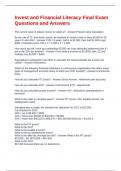Invest and Financial Literacy Final Exam
Questions and Answers
The current value in today's money is called a? - Answer-Present value calculation
By the rule of 72, how much would I be required to invest in now to have $2,000 in 28
years if I earn 8%? - Answer-72/8 = 9 years; half is to $1,000, then half $1,000 to get
$500. (It doubles twice: 500 x 2 = 1,000 x 2 = 2,000.
How much tax will I save by contributing $2,000 into a tax-deducted retirement plan if I
am ni the 22% tax bracket? - Answer-If you reduce income by $2,0000, take .22 and
multiply it by $2,000 = $440.
Expenditures subtracted in an effort to calculate the lowest possible tax income are
called? - Answer-Deductions.
Which of the following financial institutions is a full service organization that offers many
types of management accounts many of which are FDIC insured? - Answer-Commercial
bank.
How do you calculate FIT Gross? - Answer-Gross income - retirement plan accounts
How do you calculate AGI? - Answer-Total income (FIT) - adjustments
How do you calculate taxable income? - Answer-AGI - deductions (standardized or
itemized)
What is the order to calculate taxes? - Answer-FIT Gross, AGI, taxable income, tax
liability/taxes owed.
Individual who is single; the standard tax deduction for 2021 is $12,550.
Tax Bracket for 2021:
10% = up to $9,995 = $995
12% = More than $9,995 to $40,525 = $3,669
22% = More than $40,525 to $86,375 = $55,350-$40,525(.22) = $3,261.3
What is the FIT gross?
What is the AGI?
What is the taxable income?
What is the tax liability/taxes owed?
What is the after-tax average tax rate? - Answer-What is the FIT gross?
$70,000 - 3% ($70,000) = $67,900
What is the AGI?
$67,900 because there are no deductions.
, What is the taxable income?
$67,900-$12,550 = $55,350
What is the tax liability/taxes owed?
$995 + $3,669 + $3,261.3 = $7,929.3
What is the after-tax average tax rate?
(Taxed owed) $7,929.3 / $70,000 = 11.32%
Why do you use a tax bracket? - Answer-To determine the tax liability.
How do you calculate the average tax rate? - Answer-Taxes owed / gross income.
How do you calculate the marginal tax rate? - Answer-Highest tax bracket your income
falls in to.
You will pay _________ money for a future value as the number of dissenting years
becomes __________. - Answer-Less; larger.
The higher the interest rate, the more it goes up. - Answer-Future Value.
As the number of discounting periods go up, __________ will go down and you will get
less. - Answer-Present Value.
The first section of the balance sheet represents? - Answer-Assets.
How do you calculate savings? - Answer-Gross income - taxes withheld - other
expenses = savings.
What would happen to your net worth if you sold an investment you owned for $1,000
and made a payment on as a long-term loan? - Answer-Your net worth would remain
the same because your assets will go down and you liabilities will also go down.
Therefore, your net by $1,000 each of networks still stay the same. The current ratio
also would not change because your current liabilities and your monetary assets are
identical.
Taxes: they make $225,000, $10,000 contributions, no student loan interest, they have
3 kids (can only take $3,000 for each child because AGI is over $150,000).
Gross income: $225,000
401(k) contributions: $10,000
Total itemized deductions: $30,000
Standard deduction: $25,100
10% = Up to $19,900 = $1,990
12% = $19,901 to $81,050 = $7,218
22% = $81,051 to $172,750 = $20,304
24% = $172,751 to $329,850 = $2,040




